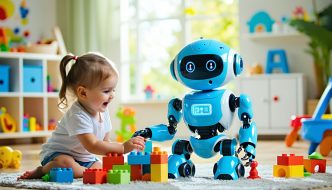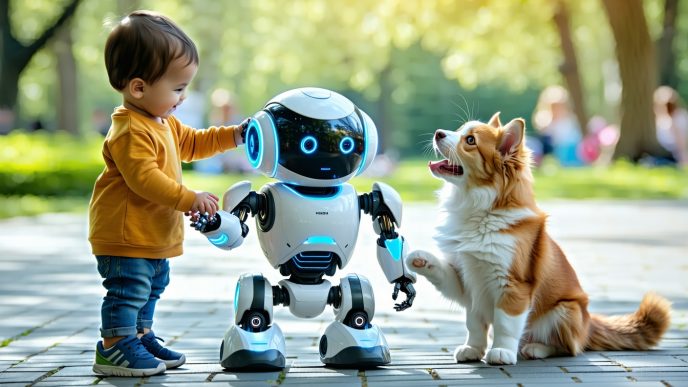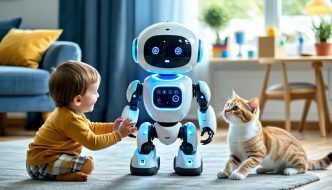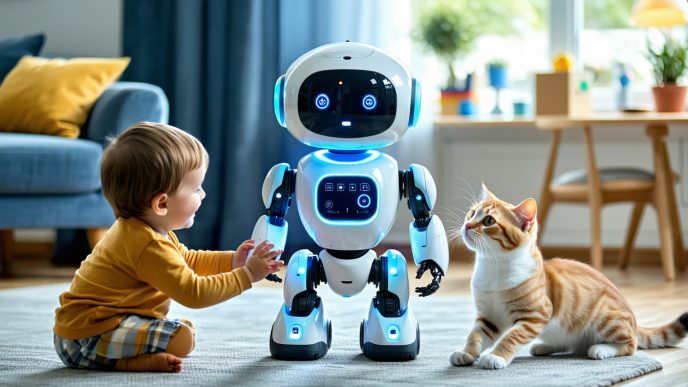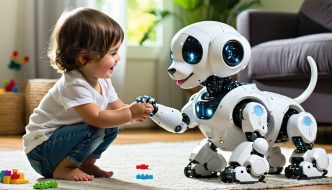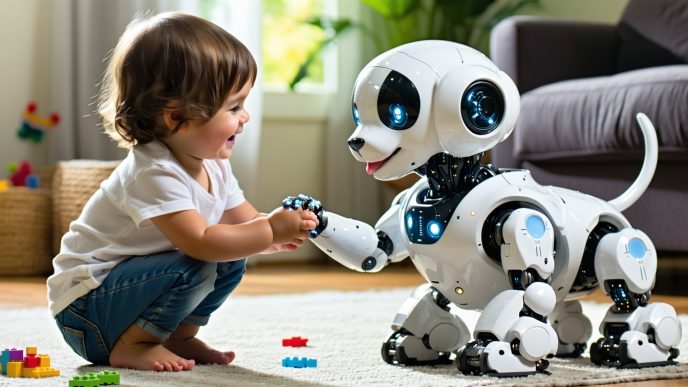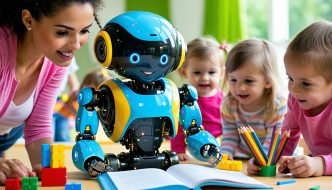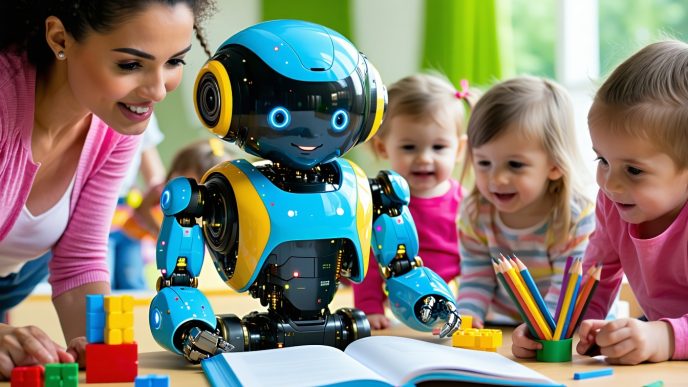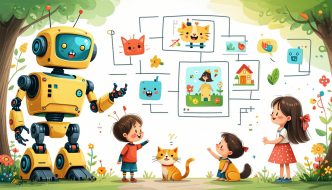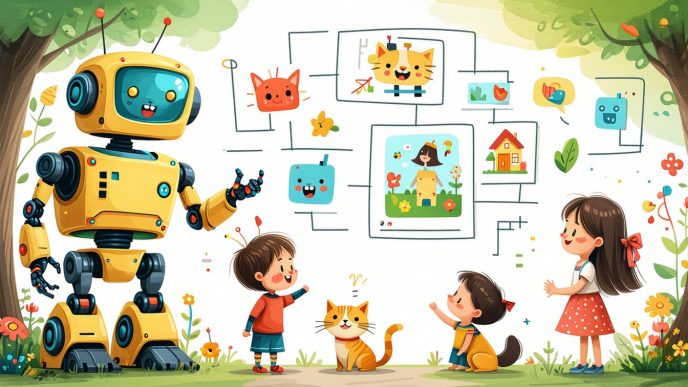The Role of Robots in Child Development
Robots have emerged as valuable tools in various aspects of child development, encompassing educational, social, and emotional growth. As technology continues to evolve, the integration of robots into daily life becomes increasingly relevant, particularly for parents looking for innovative ways to support their children.
Benefits of Robots as Learning Companions
Robots serve as effective learning companions that enhance children’s educational experiences. They offer interactive learning opportunities, helping to foster engagement and motivation. Below are some notable benefits of utilizing robots in child development:
| Benefit | Description |
|---|---|
| Interactive Learning | Robots can provide personalized learning experiences, adjusting to a child’s pace and level of understanding. They can teach subjects like mathematics, science, and languages through play. |
| Social Skills Development | Engaging with robots can help children develop social skills by encouraging communication, turn-taking, and collaboration. They can simulate conversations and activities, making learning fun. |
| Encouragement of Problem-Solving | Many robots are designed with problem-solving tasks, which can encourage critical thinking and creativity as children interact with them. |
| Safe Learning Environment | Robots create a safe space for children to explore new concepts, experiment, and learn from mistakes without the fear of making errors in a traditional classroom setting. |
The role of robots as play companions for children extends beyond simple entertainment. They can be integrated into various learning scenarios, promoting emotional bonding and curiosity. For a deeper exploration of how robots can enhance the learning experience, visit our article on child and pet interaction with robots.
Safety Concerns and Considerations
As with any technological integration in a child’s life, there are safety concerns that parents must consider when introducing robots. It is essential to evaluate the following aspects:
| Safety Concern | Consideration |
|---|---|
| Privacy Issues | Many robotic devices collect data on interactions and usage. Parents should ensure that the selected robots protect children’s privacy and do not share personal information. |
| Physical Safety | Robots should be designed with safety features to prevent injuries. Assessing the physical design, such as sharp edges or small parts, is crucial. A detailed overview of safety features can be found in our article on safety features for kids and pets in robots. |
| Over-Reliance | Encouraging independent play and learning is important for child development. Parents should monitor the use of robots to prevent over-reliance on technology. Striking a balance between robotic interaction and traditional play is essential. |
| Emotional Impact | While robots can foster emotional bonding, it is important to teach children to differentiate between relationships with robots and real-life friendships. For insights on emotional connections, refer to our article on emotional bonding with robots. |
By being aware of these benefits and safety concerns, parents can make informed decisions about integrating robots into their children’s lives. Through proper guidance, robots can serve as valuable companions that enhance learning and facilitate safe, engaging interactions.
Educational and Interactive Robots
Integrating technology into child development has increasingly involved the use of educational and interactive robots. These devices serve as engaging tools that help foster learning while providing entertainment.
How Educational Robots Support Learning
Educational robots are designed to enhance cognitive and social development in children. These robots often incorporate specific mechanisms to facilitate learning in various subjects like math, science, and language arts. They offer interactive experiences that make education enjoyable.
| Learning Aspect | Description | Benefits |
|---|---|---|
| Cognitive Skills | Robots can present challenges that require critical thinking and problem-solving. | Enhances analytical skills and logical reasoning. |
| Creativity | Many robotic learning tools encourage programming and creative storytelling. | Fosters innovation and imaginative play. |
| Collaboration | Some robots support group tasks, allowing children to work together. | Builds teamwork and communication skills. |
Robots also provide personalized feedback, which can adapt to individual learning paces. Their interactive nature keeps children engaged, promoting a love for learning. Additionally, educational robots can aid in teaching critical safety concepts through engaging activities, addressed further in the article on robots teaching safety to kids.
Features of Interactive Robots for Kids
Interactive robots designed for children come equipped with several features aimed at enhancing engagement and educational value.
| Feature | Description |
|---|---|
| Speech Recognition | Allows children to communicate with the robot, making interactions more engaging. |
| Motion Sensors | Detects movement, allowing the robot to respond to a child’s actions, making it feel more lifelike. |
| Customizable Activities | Many robots offer a range of games and tasks that can be tailored based on age and skill level. |
| Educational Apps | Some robots are compatible with mobile applications that expand their functionalities and features. |
The interactive capabilities of these robots contribute to their role as effective learning companions. They not only serve to teach but also strengthen emotional bonding, as explored in the article on emotional bonding with robots. The use of robots as play companions for children creates a unique blend of learning and fun that appeals to diverse interests and ages. For families looking to explore more opportunities in child and pet interaction, consider checking out the article on child and pet interaction with robots.
Robots as Play Companions
Robots are increasingly becoming integral play companions for children, providing both educational opportunities and entertainment. By integrating robots into playtime, families can enhance their children’s learning experiences while ensuring safety and engagement.
Enhancing Playtime with Robotic Companions
Robotic companions are designed to interact with children in fun and stimulating ways. These robots can engage children through games, stories, and creative activities, making playtime more interactive and enjoyable. The interactions encourage kids to think critically, solve problems, and embrace creativity while building essential social skills.
Many robotic toys come with various functionalities that promote active participation. The features might include voice recognition, movement, and the ability to respond to children’s commands, creating a more immersive experience. In addition, these robotic playmates can adapt their behavior based on the child’s reactions, enhancing personalized learning.
To illustrate the advantages of robotic companions, the following table highlights key features and their corresponding benefits:
| Feature | Benefit |
|---|---|
| Voice Recognition | Encourages communication and listening skills |
| Interactive Play | Promotes creativity and critical thinking |
| Adaptable Behavior | Personalizes learning experiences |
| Movement Capabilities | Enhances physical activity |
Incorporating Robotics into Play-Based Learning
Incorporating robotics into play-based learning effectively merges education with entertainment. Robots can help teach various subjects, such as science, technology, engineering, and mathematics (STEM) through engaging activities. Additionally, they can introduce themes like problem-solving, patterns, and simple coding, encouraging curiosity and exploration.
Families can design enriching play scenarios using robots as imaginative resources. For instance, using a robot to simulate a gardening project can spark discussions about biology and the environment. Moreover, these playful learning experiences promote emotional bonding, as children form connections with their robotic companions, further enhancing their social and emotional development. For more on this aspect, explore our article on emotional bonding with robots.
Overall, robots as play companions for children offer significant benefits in learning and playtime. By engaging children in interactive learning experiences, these robotic companions help foster creativity, problem-solving, and social skills while providing safe and enjoyable entertainment. For a deeper understanding of the interaction between kids and pets facilitated by robots, check out our article on child and pet interaction with robots.
Monitoring and Assistance
Robots play a pivotal role in monitoring and providing assistance within home environments, especially for families with young children and pets. The integration of robots can enhance safety measures and offer parents peace of mind while encouraging both learning and interaction.
Supervisory Role of Robots in Child Safety
One of the primary functions of robots in family settings is their ability to supervise children, helping ensure a safe environment for play and learning. Equipped with advanced sensors and cameras, these devices can detect hazards and provide alerts to parents regarding potential dangers.
The following table outlines some common safety features found in robots tailored for child supervision:
| Feature | Description |
|---|---|
| Real-time Monitoring | Robots can provide live video feeds and alerts to a parent’s smartphone. |
| Obstacle Detection | Advanced sensors allow robots to navigate around obstacles and avoid accidents. |
| Emergency Alerts | Robots can send notifications for emergencies, ensuring parents are informed promptly. |
| Child Tracking | Some robots can track a child’s location within the house, enhancing security. |
For parents looking to understand how these technological advancements can aid in safety, refer to our article on robots teaching safety to kids.
Supportive Functions of Robots for Parents
In addition to monitoring children, robots can significantly support parents in various tasks. They can act as assistants, performing a range of functions from household chores to educational activities. This multifunctionality can help alleviate daily stresses faced by parents.
Key supportive functions include:
| Function | Benefits |
|---|---|
| Activity Tracking | Robots can monitor children’s routines and activities, alerting parents when they need attention. |
| Homework Assistance | Interactive robots can engage with children during study time, providing educational support. |
| Emotional Companionship | Robots equipped for emotional bonding can interact with children, promoting social skills and emotional growth. See our article on emotional bonding with robots for more insights. |
| Pet Interaction | Some robots are equipped to monitor and interact with pets alongside children, ensuring harmonious relationships in households. Explore child and pet interaction with robots for more details. |
Using robots as support systems, parents can create a more balanced environment that fosters both child development and safety. The evolution of technology continues to enhance the ways in which families can interact and learn together, ultimately transforming home life for the better.
Pet Interaction and Supervision
Robots can play a significant role in managing the interactions between children and pets, ensuring both the safety and enjoyment of these relationships. By integrating technology into pet supervision and child engagement, families can create a more harmonious environment.
Robots as Pet Supervisors
Robotic systems designed as pet supervisors are equipped to monitor and interact with pets throughout the day. These devices can offer real-time surveillance and feedback, helping to keep pets safe and providing peace of mind for parents.
Key features of pet supervising robots often include:
| Feature | Description |
|---|---|
| Video Monitoring | Allows parents to check in on their pets remotely through a camera. |
| Activity Tracking | Monitors pet activity levels and behavior patterns, which can be reported back to parents. |
| Automated Feeding | Scheduled feeding mechanisms to ensure that pets are fed at the appropriate times. |
| Interactive Play | Engages pets with play features, keeping them active and entertained. |
These robots serve as effective tools for parents, enabling them to effortlessly oversee their pets while attending to other responsibilities. For more insight into how robots can enhance pet management at home, visit our article on robots monitoring pets at home.
Integrating Robotics for Pet-Child Interactions
In addition to supervising pets, robots can foster positive interactions between children and their furry friends. By promoting safe play practices and teaching children about pet care, these robots can significantly enhance the overall experience for both.
Some benefits of incorporating robotics into pet-child interactions include:
| Benefit | Description |
|---|---|
| Teaching Responsibility | Robots can guide children in caring for their pets, promoting a sense of ownership. |
| Encouraging Gentle Handling | Robots can demonstrate safe techniques for engaging with pets, ensuring kids learn respectful behaviors. |
| Facilitating Social Skills | Interactive robots can mediate play sessions, fostering teamwork and communication between children and pets. |
For families looking to deepen their understanding of pet and child interactions, exploring the potential of robotic companions becomes essential. To learn more about how these systems can aid in fostering positive connections, check our article on child and pet interaction with robots.
Through the strategic application of robotic technologies in supervising pets and facilitating child interactions, families can enhance safety and enrich their experiences at home.

